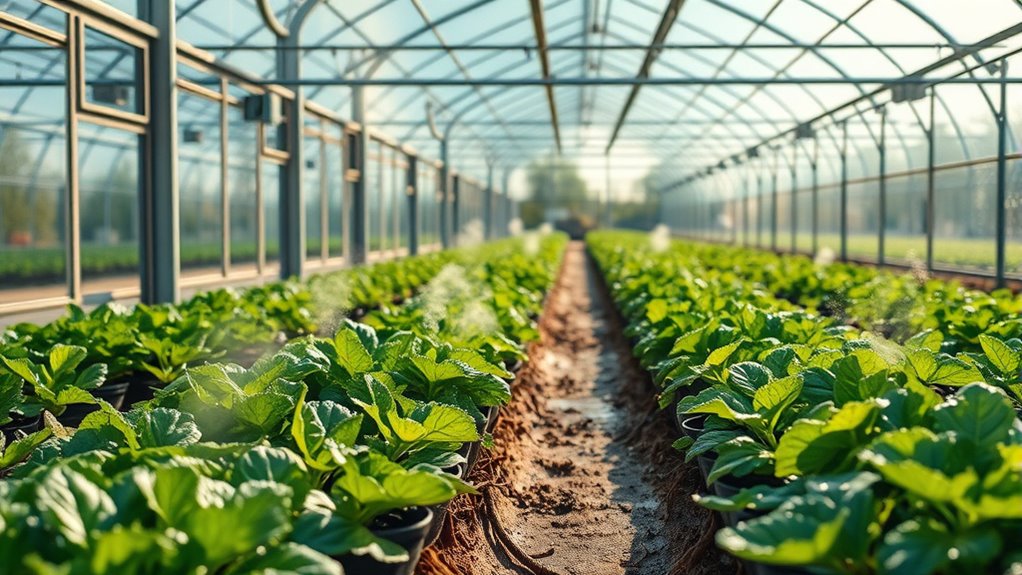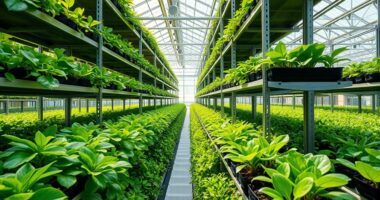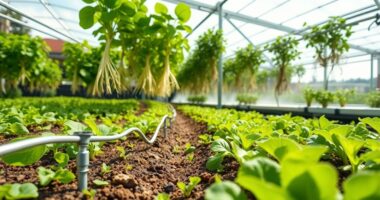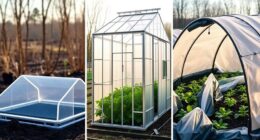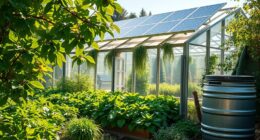Automated climate control systems for greenhouses help you optimize the environment by precisely managing temperature, humidity, CO2 levels, and irrigation. This technology enhances plant growth, increases yields, and saves resources. With real-time monitoring and adjustments, you can reduce labor and operational costs while ensuring healthier crops. Plus, these systems contribute to sustainable farming practices by minimizing waste. There’s much more to discover about how these innovations can transform your greenhouse operations.
Key Takeaways
- Automated climate control systems optimize temperature, humidity, CO2 levels, and lighting to enhance plant growth and maximize crop yields.
- IoT technology allows for remote monitoring and control, enabling real-time adjustments to greenhouse conditions via smartphones.
- Integration of renewable energy sources helps reduce energy costs while maintaining efficient heating, cooling, and lighting within the greenhouse.
- Automated irrigation systems adjust water delivery based on soil moisture data, promoting water conservation and improving resource efficiency.
- Advanced technologies facilitate data-driven agricultural practices, enabling selective pest control and minimizing chemical usage for sustainable farming.
Understanding Automated Climate Control Systems

As you explore automated climate control systems, you’ll discover how they play a crucial role in optimizing greenhouse environments.
These systems regulate temperature, utilizing heaters, coolers, and ventilation to ensure ideal growth conditions. Humidity management is equally vital, with humidifiers and dehumidifiers maintaining optimal moisture levels to prevent issues.
They also control CO2 levels and lighting, enhancing photosynthesis. Automated irrigation systems provide the right amount of water based on real-time soil moisture data, ensuring your plants thrive.
Equipped with sensors, climate computers, and automation software, these systems adapt to changing conditions. With IoT technology, you can even monitor and control your greenhouse from your smartphone, making your operation more efficient and effective.
The Importance of Precision and Consistency

Automated climate control systems significantly enhance greenhouse operations, but their effectiveness hinges on precision and consistency.
When you maintain optimal temperature, humidity, and light conditions, you maximize yield and improve crop quality. Consistent environmental factors reduce plant stress, promoting healthier growth and minimizing disease risks. Additionally, emergency preparedness strategies can improve resilience against unexpected climate events that may impact your greenhouse. Understanding wilderness survival techniques can also help you manage unexpected issues effectively. Using appropriate techniques for optimal flow can further enhance your greenhouse’s climate management. Furthermore, adopting a well-structured budget for greenhouse operations can safeguard against financial uncertainties.
Precise control also optimizes resource usage, saving water, nutrients, and energy, which ultimately cuts costs. With real-time data from sensors, you can make informed decisions and quickly adjust conditions as needed.
This consistency in climate not only supports photosynthesis and metabolic processes but also enhances your market competitiveness with higher-quality crops. Additionally, implementing backyard greenhouses allows gardeners of all experience levels to reap the benefits of automated climate control.
In essence, precision and consistency are vital for successful, sustainable greenhouse management.
Time and Labor Efficiency in Greenhouse Management

Effective greenhouse management relies heavily on time and labor efficiency, which can be achieved through strategic automation and innovative technologies.
By implementing automation systems for tasks like temperature control, irrigation, and lighting, you can drastically reduce manual labor time. Advanced analytics help you optimize planting schedules and predict demand, ensuring resources are used efficiently.
Implementing automation for temperature control, irrigation, and lighting significantly cuts manual labor time while optimizing resource use.
Real-time inventory tracking minimizes time spent on checks, while automated environmental monitoring reduces the need for manual adjustments. Additionally, integrating various technologies streamlines operations, allowing skilled workers to focus on more complex tasks.
With these strategies in place, you’ll not only save time but also enhance overall labor efficiency in your greenhouse management efforts.
Enhanced Plant Growth and Increased Yields
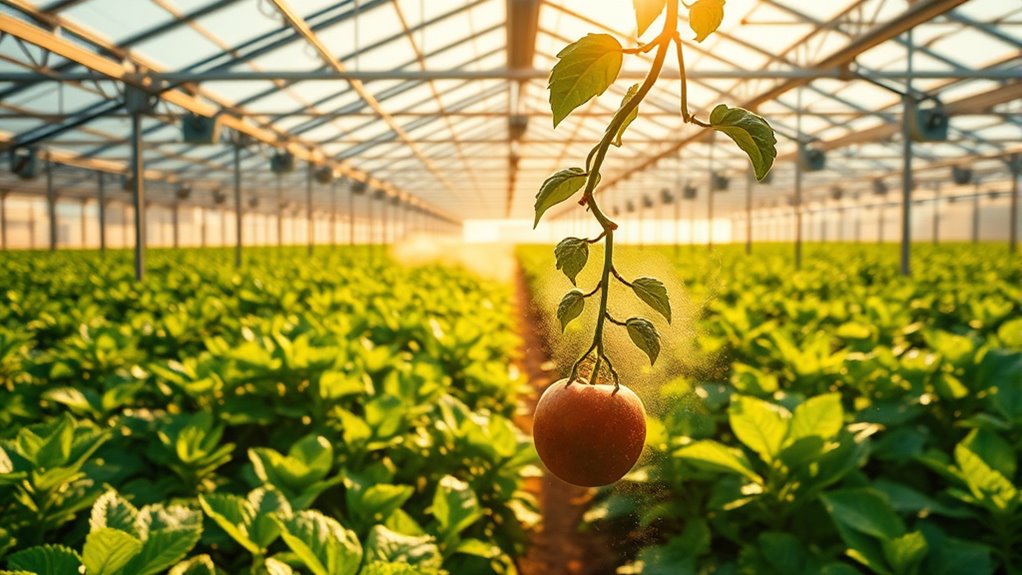
Implementing automated systems not only boosts time and labor efficiency but also significantly enhances plant growth and increases yields.
By optimizing environmental conditions like temperature, humidity, and CO2 levels, you create the perfect setting for plants to thrive. Improved photosynthesis occurs under these ideal conditions, leading to healthier growth.
Automated systems reduce plant stress and ensure uniform crop development, while also enhancing disease resistance. With precision control and tailored microclimates, you can maximize each crop’s potential.
Real-time monitoring allows for immediate adjustments, ensuring consistent application of essential tasks. This means you can enjoy year-round production and ultimately, higher quality crops that have a longer shelf life.
Embracing automation truly transforms your greenhouse operations.
Energy and Resource Efficiency Benefits
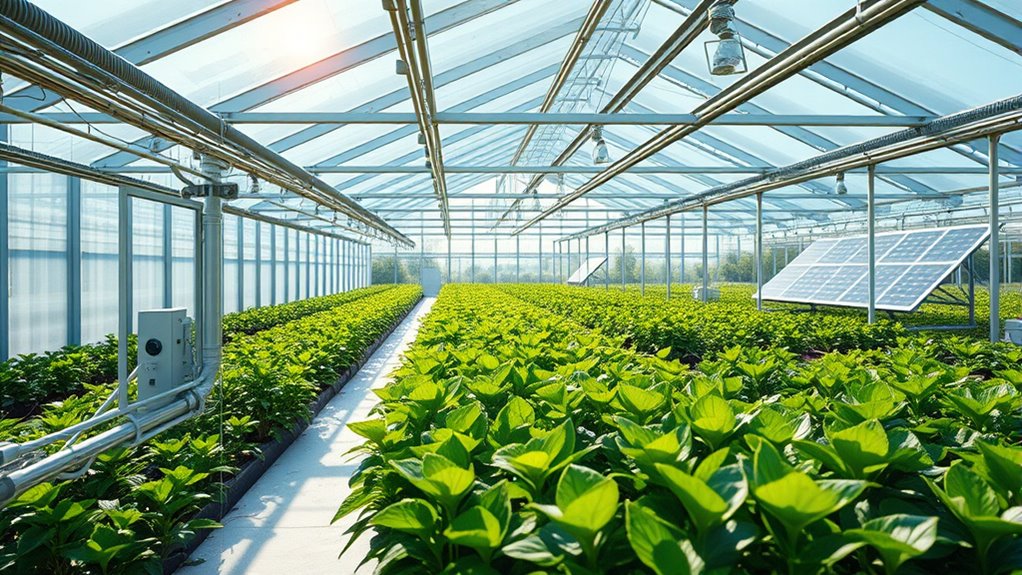
As greenhouse operators seek to optimize their operations, energy and resource efficiency become essential to sustainable growth.
By integrating renewable energy sources like solar panels, you can significantly cut energy costs and reduce fossil fuel reliance.
Automated climate control systems ensure that heating, cooling, and lighting are used only when necessary, enhancing energy savings.
Efficient heating systems, like heat pumps, provide better energy use, while thermal screens help maintain temperature, reducing heating and cooling needs.
On the resource side, automated irrigation systems conserve water by adjusting to real-time data, and precise fertilizer management minimizes waste.
With these efficiencies, you not only lower operational costs but also improve crop quality, leading to increased profitability and market competitiveness.
Scalability of Automated Climate Control Systems

When considering the scalability of automated climate control systems, it’s clear that their modular design offers significant advantages for greenhouse operators. You can easily expand or contract these systems based on your production needs, allowing for customization to meet the specific environmental requirements of various crops.
This flexibility supports both small-scale pilot projects and large-scale commercial operations. Advanced technologies like LED grow lights and automated nutrient delivery enhance efficiency, making it simpler to scale up operations.
Plus, centralized control systems and remote monitoring simplify management, ensuring optimal conditions year-round. By integrating with existing infrastructure, you can reduce initial costs while optimizing resource use, ultimately increasing productivity and maintaining market competitiveness.
Integrating New Technologies for Future Adaptability

Automated climate control systems not only provide scalability for greenhouse operations but also pave the way for integrating new technologies that enhance future adaptability.
By incorporating renewable energy sources like solar and wind power, you can reduce energy costs and your carbon footprint.
AI and machine learning play a crucial role in predictive climate management, allowing you to adjust conditions proactively based on real-time data.
IoT-enabled systems provide constant monitoring and smart resource utilization, making it easier for you to control your greenhouse from anywhere.
With precision climate control, you can tailor conditions to specific crop needs, ensuring healthier plants and increased yields. Additionally, utilizing solar energy solutions can further enhance the sustainability of your greenhouse operations.
Sustainable Agricultural Practices Through Automation
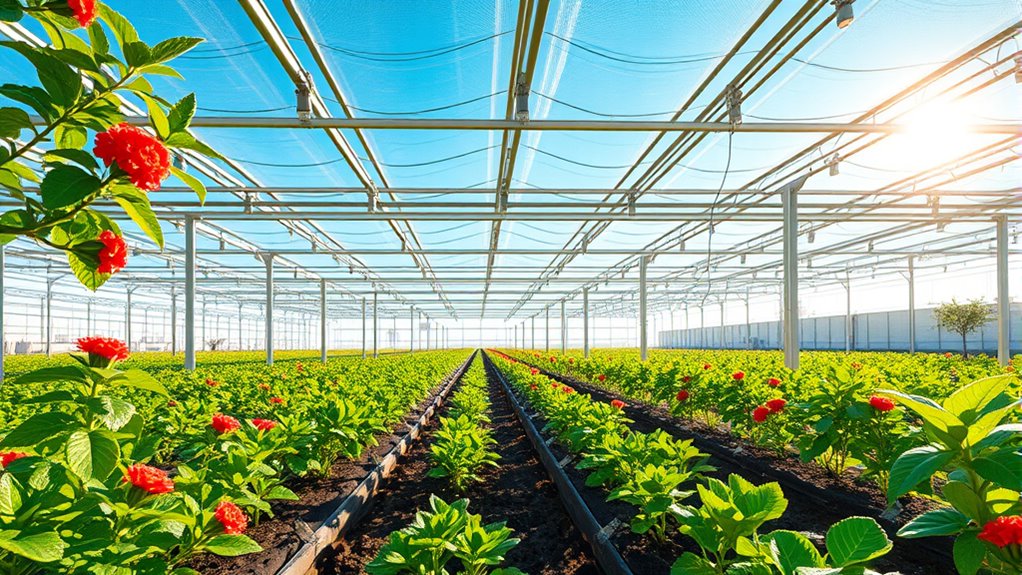
Sustainable agricultural practices are becoming increasingly vital in today’s world, and automation is leading the charge in making farming more efficient and environmentally friendly.
With tools like automated irrigation systems, you can optimize water usage and drastically reduce waste. Climate control systems help you manage energy costs by regulating vents, shading, and lighting. By maintaining optimal growing conditions, greenhouse automation enhances crop health and boosts yields.
Plus, precision irrigation and crop monitoring allow you to make data-driven decisions, minimizing resource waste. Advanced technologies even enable selective spraying and pest control, cutting down chemical use.
Frequently Asked Questions
What Is the Initial Cost of Installing an Automated Climate Control System?
The initial cost of installing an automated climate control system can vary widely based on factors like technology and complexity.
You might expect to spend anywhere from $5,000 for basic setups to significantly more for advanced systems.
It’s essential to consider the specific features you need, as additional sensors and controls can increase your investment.
How Long Does It Take to Implement These Systems in a Greenhouse?
When you’re looking to implement a new system, the timeline can vary based on complexity and size.
Generally, you can expect the entire process to take anywhere from a few weeks to several months.
You’ll need to factor in time for planning, installation, and testing.
Consulting with experts can help you streamline the process and set realistic expectations, ensuring everything’s ready for a smooth launch and optimal performance.
Can I Use Automated Systems for All Types of Crops?
Ever heard the phrase “you can’t have your cake and eat it too”?
Well, when it comes to automated systems, you actually can! You can use these systems for a variety of crops, including vegetables, fruits, flowers, herbs, and even microgreens.
They provide precise control over essential growth factors, making them suitable for diverse plants.
Just remember, each crop might need specific adjustments to optimize their growth successfully.
What Maintenance Is Required for Automated Climate Control Systems?
To keep your automated climate control system running smoothly, you’ll need to perform regular maintenance. This includes calibrating sensors, cleaning fans, and checking pumps and valves.
Don’t forget to maintain heating and cooling units by replacing filters when necessary. Regular software updates and algorithm adjustments ensure optimal performance.
Additionally, consistently monitor environmental conditions and conduct inspections to catch potential issues early. Training and having spare parts on hand will help minimize downtime.
Are There Any Specific Brands Recommended for Greenhouse Automation?
When it comes to greenhouse automation, choosing the right brand can feel like finding a diamond in a sea of pebbles.
You’ll want to consider Priva Holding for its precise climate control, or Hoogendoorn for advanced environmental systems.
HortiMaX leads globally, while Logiqs B.V. streamlines operations effortlessly.
Don’t overlook Van der Hoeven’s fully automated solutions.
Each brand offers unique features that can elevate your greenhouse productivity and efficiency.
Conclusion
In a world where you can control everything from your thermostat to your coffee maker, it seems almost absurd to leave your greenhouse’s climate to chance, doesn’t it? By embracing automated climate control systems, you’re not just ensuring precision and efficiency; you’re also ironically wrestling control over nature itself. While you might think you’re merely optimizing conditions for your plants, you’re actually paving the way for sustainable agriculture and a greener future. Who knew technology could be so nurturing?
